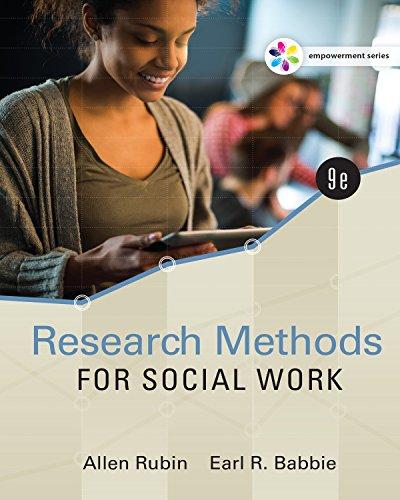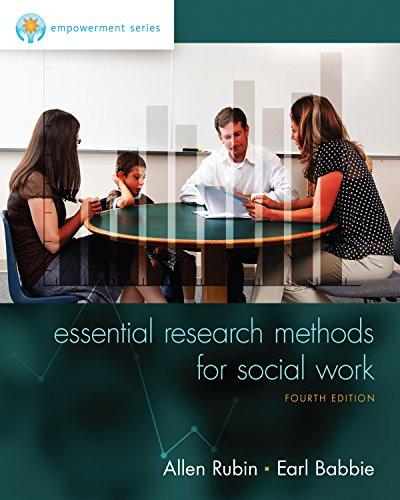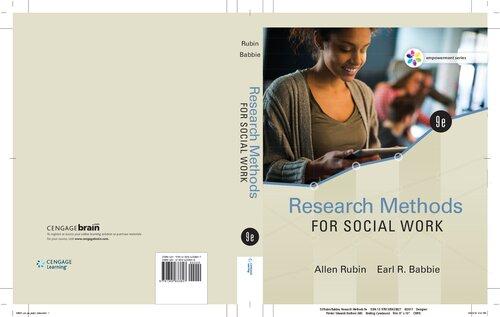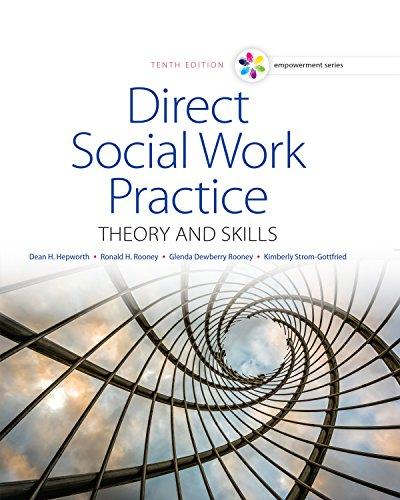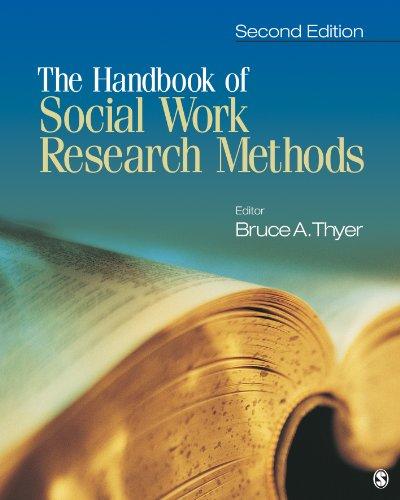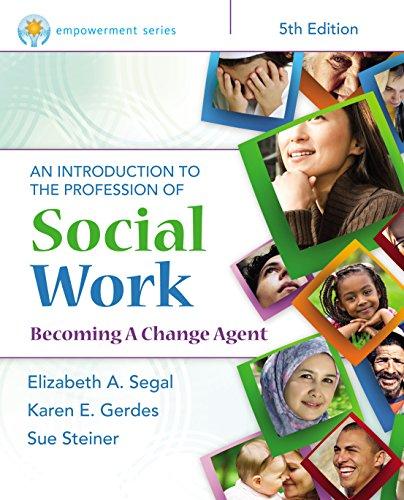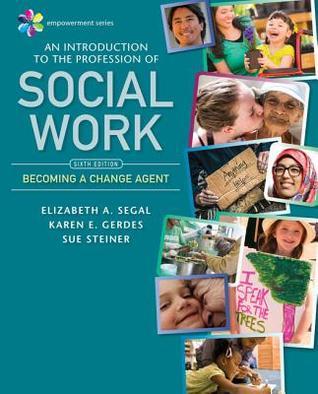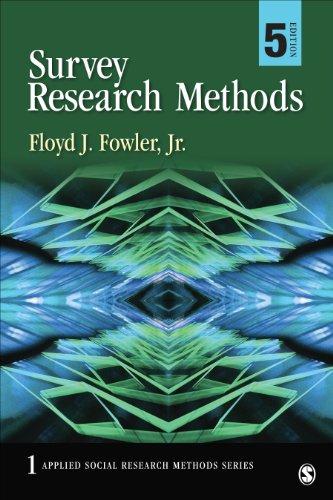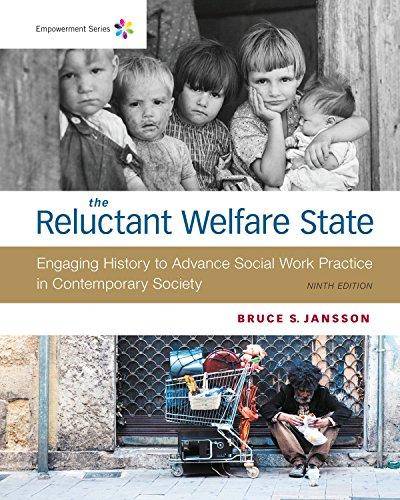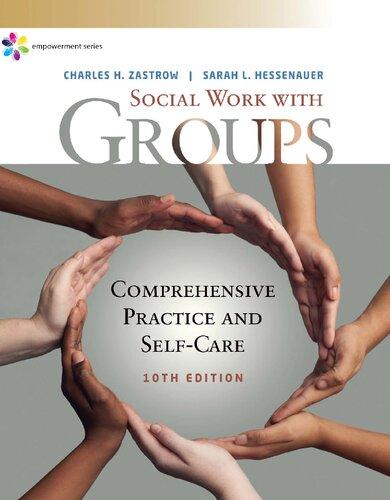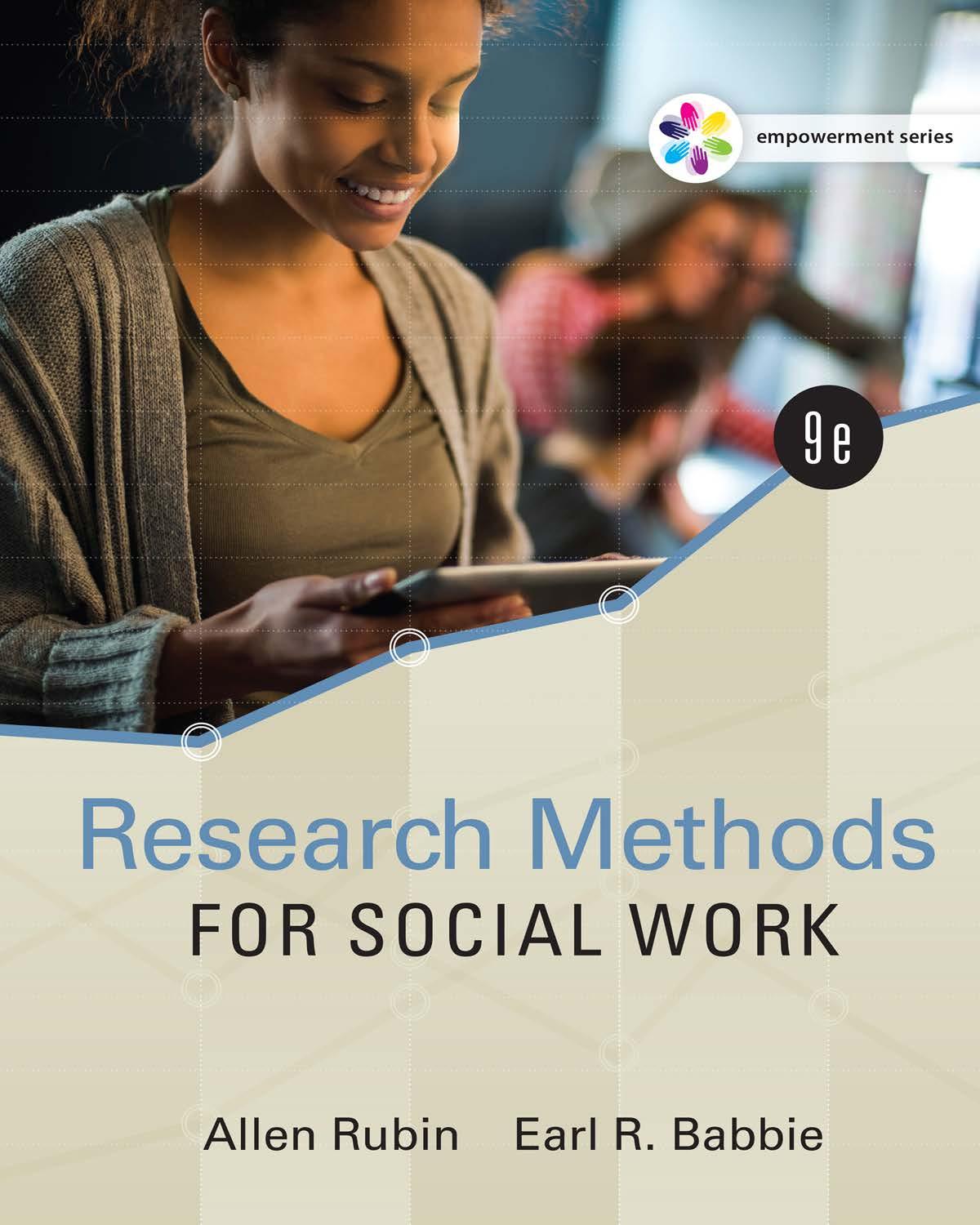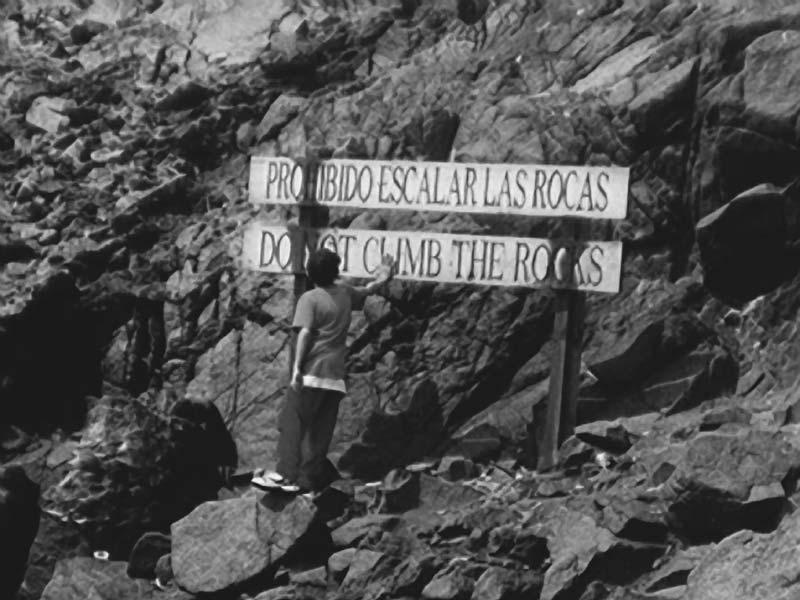Visit to download the full and correct content document: https://ebookmass.com/product/empowerment-series-research-methods-for-social-wo rk-9th-edition-ebook-pdf/
More products digital (pdf, epub, mobi) instant download maybe you interests ...
Empowerment Series: Essential Research Methods for Social Work 4th Edition, (Ebook PDF)
https://ebookmass.com/product/empowerment-series-essentialresearch-methods-for-social-work-4th-edition-ebook-pdf/
Research Methods for Social Work 9e Edition Allen Rubin
https://ebookmass.com/product/research-methods-for-socialwork-9e-edition-allen-rubin/
Empowerment Series: Direct Social Work Practice: Theory and Skills 10th Edition, (Ebook PDF)
https://ebookmass.com/product/empowerment-series-direct-socialwork-practice-theory-and-skills-10th-edition-ebook-pdf/
The Handbook of Social Work Research Methods – Ebook PDF Version
https://ebookmass.com/product/the-handbook-of-social-workresearch-methods-ebook-pdf-version/
Empowerment Series: An Introduction to the Profession of Social Work 5th Edition, (Ebook PDF)
https://ebookmass.com/product/empowerment-series-an-introductionto-the-profession-of-social-work-5th-edition-ebook-pdf/
Empowerment Series: An Introduction to the Profession of Social Work Elizabeth A. Segal
https://ebookmass.com/product/empowerment-series-an-introductionto-the-profession-of-social-work-elizabeth-a-segal/
Survey Research Methods (Applied Social Research Methods Book 1) 5th Edition, (Ebook PDF)
https://ebookmass.com/product/survey-research-methods-appliedsocial-research-methods-book-1-5th-edition-ebook-pdf/
Empowerment Series: The Reluctant Welfare State 9th Edition – Ebook PDF Version
https://ebookmass.com/product/empowerment-series-the-reluctantwelfare-state-9th-edition-ebook-pdf-version/
Empowerment Series: Social Work with Groups: Comprehensive Practice and Self-Care 10th Edition Charles Zastrow
https://ebookmass.com/product/empowerment-series-social-workwith-groups-comprehensive-practice-and-self-care-10th-editioncharles-zastrow/
Toourwives CHRISTINARUBIN SUZANNEBABBIE CONTENTSINBRIEF PART1
AnIntroductiontoScientificInquiryin SocialWork1
Chapter1 WhyStudyResearch?2
Chapter2 Evidence-BasedPractice24
Chapter3 FactorsInfluencingtheResearch Process43
Chapter4 Quantitative,Qualitative,andMixed MethodsofInquiry66
PART2
TheEthical,Political,andCulturalContextof SocialWorkResearch81
Chapter5 TheEthicsandPoliticsofSocialWork Research82
Chapter6 CulturallyCompetentResearch112
PART3 ProblemFormulationandMeasurement139
Chapter7 ProblemFormulation140
Chapter8 ConceptualizationinQuantitative andQualitativeInquiry162
Chapter9 Measurement191
Chapter10 ConstructingMeasurement Instruments218
PART4
DesignsforEvaluatingPrograms andPractice241
Chapter11 CausalInferenceandExperimental Designs243
Chapter12 Quasi-ExperimentalDesigns272
Chapter13 Single-CaseEvaluationDesigns292
Chapter14 ProgramEvaluation320
PART5 DataCollectionMethodswithLargeSources ofData347
Chapter15 Sampling349
Chapter16 SurveyResearch378
Chapter17 AnalyzingExistingData:Quantitative andQualitativeMethods403
PART6 QualitativeResearchMethods433
Chapter18 QualitativeResearch:General Principles434
Chapter19 QualitativeResearch:Specific Methods455
Chapter20 QualitativeDataAnalysis478
PART7 AnalysisofQuantitativeData503
Chapter21 DescriptiveDataAnalysis504 Chapter22 InferentialDataAnalysis528
PART8
WritingResearchProposalsandReports551
Chapter23 WritingResearchProposals andReports552
AppendixA UsingtheLibrary577
AppendixB StatisticsforEstimatingSampling Error584
AppendixC CriticallyAppraising Meta-Analyses593
Glossary 596 Bibliography 617 Index 637
CONTENTSINDETAIL Prefacexvi
PART1
AnIntroductiontoScientificInquiryinSocial Work1
Chapter 1
WHYSTUDYRESEARCH?2
Introduction 3
AgreementReality3
ExperientialReality4
TheScientificMethod 4
AllKnowledgeIsTentativeandOpento Question4
Replication5
Observation5
Objectivity6
Transparency6
OtherWaysofKnowing 6
Tradition7
Authority8
CommonSense8
PopularMedia8
RecognizingFlawsinUnscientificSourcesofSocial WorkPracticeKnowledge 10
Overgeneralization10
SelectiveObservation10
ExPostFacto Hypothesizing12
EgoInvolvementinUnderstanding12
OtherFormsofIllogicalReasoning13
ThePrematureClosureofInquiry14
Pseudoscience14
TheUtilityofScientificInquiryinSocialWork 16
WillYouEverDoResearch?16
ReviewsofSocialWorkEffectiveness 17
EarlyReviews17
StudiesofSpecificInterventions17
TheNeedtoCritiqueResearchQuality 19 PublicationDoesNotGuaranteeQuality19 DistinguishingandFacilitatingMoreUseful Studies19
CompassionandProfessionalEthics 19
UtilityofResearchinAppliedSocialWork Settings 20
ResearchMethodsYouMaySomedayUseinYour Practice20
NationalAssociationofSocialWorkersCodeof Ethics21
MainPoints 21
ReviewQuestionsandExercises 22
InternetExercises 22
Chapter 2
EVIDENCE-BASEDPRACTICE24
Introduction 25
CriticalThinkinginEBP 25
EBPImpliesCareer-LongLearning 26
StepsintheEBPProcess 27
Step1.FormulateaQuestiontoAnswerPractice Needs27
Step2.SearchfortheEvidence29
Step3.CriticallyAppraisetheRelevantStudiesYou Find33
Step4.DetermineWhichResearch-Supported InterventionorPolicyIsMostAppropriatefor YourParticularClient(s)33
Step5.ApplytheChosenIntervention34
Step6.ProvideEvaluationandFeedback35 DistinguishingtheEvidence-BasedProcessfrom Evidence-BasedPractices 35
ControversiesandMisconceptionsaboutEBP 37
EBPIsBasedonStudiesofAtypicalClients37
EBPIsOverlyRestrictive37
EBPIsJustaCost-CuttingTool38
EvidenceIsinShortSupply38
TheTherapeuticAllianceWillBeHindered38
CommonFactorsandtheDodoBird 38
Real-WorldObstaclestoImplementingEBPin
EverydayPractice 39
AlleviatingFeasibilityObstaclestoEBP40
MainPoints 40
ReviewQuestionsandExercises 41
InternetExercises 41
Chapter 3
FACTORSINFLUENCINGTHERESEARCH PROCESS43
Introduction 44
ThePhasesoftheResearchProcess 44
TheoryandValues 47
UtilityofTheoryinSocialWorkPractice andResearch47
SocialWorkPracticeModels48
AtheoreticalResearchStudies49
PredictionandExplanation49
TheComponentsofTheory50
TheRelationshipbetweenAttributes andVariables51
TwoLogicalSystems:ComparingDeduction andInduction 53
ProbabilisticKnowledge 56
TwoCausalModelsofExplanation 57
UseofNomotheticandIdiographicResearch inSocialWorkPractice58
IdeologiesandParadigms 59
ContemporaryPositivism61 Interpretivism62
EmpowermentParadigm63
ParadigmaticFlexibilityinResearch63
MainPoints 64
ReviewQuestionsandExercises 65
InternetExercises 65
Chapter 4
QUANTITATIVE,QUALITATIVE,ANDMIXED METHODSOFINQUIRY66
Introduction 67
ObjectivityandSubjectivityinScientific Inquiry 67
AComparisonofQualitativeandQuantitative MethodsofInquiry 68
MixedMethodsofInquiry 70
TypesofMixed-MethodsDesigns71
ThreeBasicMixed-MethodsDesigns74
ThreeAdvancedMixed-MethodsDesigns77
ReasonsforUsingMixedMethods77
MainPoints 78
Practice-RelatedExercises 79
InternetExercises 79
PART2 TheEthical,Political,andCulturalContext ofSocialWorkResearch81
Chapter 5
THEETHICSANDPOLITICSOFSOCIAL WORKRESEARCH82
Introduction 83
InstitutionalReviewBoards 84
VoluntaryParticipationandInformed Consent85
NoHarmtotheParticipants86
AnonymityandConfidentiality87
DeceivingParticipants90
AnalysisandReporting90
WeighingBenefitsandCosts91
RighttoReceiveServicesversusResponsibility toEvaluateServiceEffectiveness92
NationalAssociationofSocialWorkersCode ofEthics93
IRBProceduresandForms94
TrainingRequirement94
ExpeditedReviews94
OverzealousReviewers97
FourEthicalControversies 98
ObservingHumanObedience98
TroubleintheTearoom100
“WelfareStudyWithholdsBenefitsfrom800 Texans” 101
SocialWorkerSubmitsBogusArticletoTestJournal Bias102
BiasandInsensitivityRegardingSex,Gender Identity,andCulture 105
ThePoliticsofSocialWorkResearch 106
SocialResearchandRace107
MainPoints 109
ReviewQuestionsandExercises 110
InternetExercises 111
Chapter 6
CULTURALLYCOMPETENTRESEARCH112 Introduction 113
ResearchParticipants113
Measurement113
DataAnalysisandInterpretation114
Acculturation115
ImpactofCulturalInsensitivityonResearch Climate116
DevelopingCulturalCompetence 116
RecruitingandRetainingtheParticipation ofMinorityandOppressedPopulationsin ResearchStudies119
ObtainEndorsementfromCommunity Leaders119
UseCulturallySensitiveApproachesRegarding Confidentiality120
EmployLocalCommunityMembersasResearch Staff120
ProvideAdequateCompensation120
AlleviateTransportationandChild-Care Barriers121
ChooseaSensitiveandAccessibleSetting121
UseandTrainCulturallyCompetent Interviewers121
UseBilingualStaff122
UnderstandCulturalFactorsInfluencing Participation122
UseAnonymousEnrollmentwithStigmatized Populations122
UtilizeSpecialSamplingTechniques123
LearnWheretoLook123
ConnectwithandNurtureReferralSources124
UseFrequentandIndividualizedContacts andPersonalTouches124
UseAnchorPoints125
UseTrackingMethods125
CulturallyCompetentMeasurement 126
CulturallyCompetentInterviewing126
LanguageProblems127
CulturalBias128
MeasurementEquivalence 130
LinguisticEquivalence130
ConceptualEquivalence131
MetricEquivalence131
AssessingMeasurementEquivalence132 MethodsforImprovingMeasurement Equivalence133
TheValueofQualitativeInterviews133 ProblematicIssuesinMakingResearchMore CulturallyCompetent 133
MainPoints 135
ReviewQuestionsandExercises 137
InternetExercises 137 PART3 ProblemFormulationandMeasurement139
Chapter 7
PROBLEMFORMULATION140 Introduction 141
PurposesofSocialWorkResearch 141 Exploration141
Description141
Explanation142
Evaluation142
ConstructingMeasurementInstruments143
MultiplePurposes 143
SelectingTopicsandResearchQuestions 143
NarrowingResearchTopicsintoResearch Questions 145
AttributesofGoodResearchQuestions 146
Feasibility147
InvolvingOthersinProblemFormulation 149
LiteratureReview 150
WhyandWhentoReviewtheLiterature150
HowtoReviewtheLiterature151
SearchingtheWeb152
BeThorough152
TheTimeDimension 156
Cross-SectionalStudies156
LongitudinalStudies156
UnitsofAnalysis 158
MainPoints 160
ReviewQuestionsandExercises 161
InternetExercises 161
Chapter 8
CONCEPTUALIZATIONINQUANTITATIVE ANDQUALITATIVEINQUIRY162
Introduction 163
ContrastingQuantitativeandQualitative Conceptualization 163
ConceptualExplicationinQuantitative Inquiry 164
DevelopingaProperHypothesis165
DifferencesbetweenHypothesesandResearch Questions166
TypesofRelationshipsbetweenVariables166
ExtraneousVariables167
ModeratingVariables168
Constants169
MediatingVariables169
TheSameConceptCanBeaDifferentTypeof VariableinDifferentStudies170
OperationalDefinitions 172
OperationallyDefiningAnythingThatExists173
Conceptualization174
IndicatorsandDimensions175
ClarifyingConcepts176
TheInfluenceofOperationalDefinitions178
SexandCulturalBiasinOperational Definitions178
OperationalizationChoices 179
RangeofVariation179
VariationsbetweentheExtremes180 ANoteonDimensions180
ExamplesofOperationalizationinSocial Work 180
ExistingScales 182
OperationalizationGoesOnandOn 186
LevelsofMeasurement 186
ConceptualizationinQualitativeInquiry 187
MainPoints 189
ReviewQuestionsandExercises 190
InternetExercises 190
Chapter 9 MEASUREMENT191
Introduction 192
CommonSourcesofMeasurementError 192
SystematicError192 RandomError195
ErrorsinAlternateFormsofMeasurement195
AvoidingMeasurementError 197
Reliability 199
TypesofReliability200
InterobserverandInterraterReliability200
Test–RetestReliability201
InternalConsistencyReliability201
Validity 202
FaceValidity203
ContentValidity203
Criterion-RelatedValidity204
ConstructValidity206
FactorialValidity207
AnIllustrationofReliableandValidMeasurement inSocialWork:TheClinicalMeasurement Package 208
RelationshipbetweenReliabilityandValidity 211
ReliabilityandValidityinQualitative Research 214
MainPoints 216
ReviewQuestionsandExercises 217
InternetExercises 217
Chapter 10
CONSTRUCTINGMEASUREMENT INSTRUMENTS218
Introduction 219
GuidelinesforAskingQuestions 219
QuestionsandStatements220
Open-EndedandClosed-EndedQuestions220
MakeItemsClear221
AvoidDouble-BarreledQuestions221
RespondentsMustBeCompetentto Answer221
RespondentsMustBeWillingto Answer222
QuestionsShouldBeRelevant222
ShortItemsAreBest222
AvoidWordsLike No or Not 222
AvoidBiasedItemsandTerms223
QuestionsShouldBeCulturallySensitive223
QuestionnaireConstruction 223
GeneralQuestionnaireFormat223
FormatsforRespondents225
ContingencyQuestions225
MatrixQuestions227
OrderingQuestionsinaQuestionnaire227
QuestionnaireInstructions228
PretestingtheQuestionnaire229
ConstructingScales 229
LevelsofMeasurement230
SomeProminentScalingProcedures231
ItemGenerationandSelection232
HandlingMissingData234
ConstructingQualitativeMeasures 235
MainPoints 237
ReviewQuestionsandExercises 238
InternetExercises 238
PART4 DesignsforEvaluatingPrograms andPractice241
Chapter 11 CAUSALINFERENCEANDEXPERIMENTAL DESIGNS243
Introduction 244
CriteriaforInferringCausality 244
TimeSequence245
Correlation246
RulingOutAlternativeExplanations246
StrengthofCorrelation246
PlausibilityandCoherence246
ConsistencyinReplication248
InternalValidity 248
PreexperimentalPilotStudies 252
One-ShotCaseStudy252
One-GroupPretest–PosttestDesign252
Posttest-OnlyDesignwithNonequivalentGroups (Static-GroupComparisonDesign)253
ExperimentalDesigns 254
Randomization259
Matching259
ProvidingServicestoControlGroups261
AdditionalThreatstotheValidityofExperimental Findings 262
MeasurementBias262
ResearchReactivity262
DiffusionorImitationofTreatments264
CompensatoryEqualization,CompensatoryRivalry, orResentfulDemoralization266
Attrition(ExperimentalMortality) 266
ExternalValidity 268
MainPoints 270
ReviewQuestionsandExercises 271
InternetExercises 271
Chapter 12
QUASI-EXPERIMENTALDESIGNS272
Introduction 273
NonequivalentComparisonGroupsDesign 273
WaystoStrengthentheInternalValidityofthe NonequivalentComparisonGroups Design 274
MultiplePretests275
SwitchingReplication276
SimpleTime-SeriesDesigns 276
MultipleTime-SeriesDesigns 279
Cross-SectionalStudies 280
CaseControlStudies 283
PracticalPitfallsinCarryingOutExperiments andQuasiExperimentsinSocialWork Agencies 284
FidelityoftheIntervention285
ContaminationoftheControlCondition286
ResistancetotheCaseAssignmentProtocol286
ClientRecruitmentandRetention286
MechanismsforAvoidingorAlleviatingPractical Pitfalls287
QualitativeTechniquesforAvoidingorAlleviating PracticalPitfalls 288
MainPoints 290
ReviewQuestionsandExercises 290
InternetExercises 291
Chapter 13
SINGLE-CASEEVALUATIONDESIGNS292
Introduction 293
OverviewoftheLogicofSingle-CaseDesigns 293
Single-CaseDesignsinSocialWork 295
UseofSingle-CaseDesignsasPartofEvidenceBasedPractice 296
MeasurementIssues 298
OperationallyDefiningTargetProblems andGoals298
WhattoMeasure299
Triangulation299
DataGathering 300 WhoShouldMeasure?300
SourcesofData301
ReliabilityandValidity301
DirectBehavioralObservation301
UnobtrusiveversusObtrusiveObservation302
DataQuantificationProcedures303
TheBaselinePhase303
AlternativeSingle-CaseDesigns 306
AB:TheBasicSingle-CaseDesign306
ABAB:Withdrawal/ReversalDesign307
Multiple-BaselineDesigns309
Multiple-ComponentDesigns312
DataAnalysis 313
InterpretingAmbiguousResults314
AggregatingtheResultsofSingle-CaseResearch Studies315
BandB+Designs 316
TheRoleofQualitativeResearchMethods inSingle-CaseEvaluation 317
MainPoints 318
ReviewQuestionsandExercises 319
InternetExercises 319
Chapter 14 PROGRAMEVALUATION320
Introduction 321
HistoricalOverview 321
TheImpactofManagedCare322 Evidence-BasedPractice323 PlanninganEvaluationandFosteringIts Utilization 323 LogicModels324
PurposesandTypesofProgramEvaluation 327
SummativeandFormativeEvaluations327 EvaluatingOutcomeandEfficiency328 Cost-EffectivenessandCost–BenefitAnalyses329 ProblemsandIssuesinEvaluatingGoal Attainment330 MonitoringProgramImplementation331 ProcessEvaluation332
EvaluationforProgramPlanning:Needs Assessment333 FocusGroups336
AnIllustrationofaQualitativeApproachto EvaluationResearch 337
ThePoliticsofProgramEvaluation 339 In-HouseversusExternalEvaluators340
UtilizationofProgramEvaluationFindings342
LogisticalandAdministrativeProblems343
MainPoints 344
ReviewQuestionsandExercises 345
InternetExercises 346
PART5
DataCollectionMethodswithLargeSources ofData347
Chapter 15
SAMPLING349
Introduction 350
PresidentAlfLandon351
PresidentThomasE.Dewey351
PresidentJohnKerry352
NonprobabilitySampling 352
RelianceonAvailableSubjects353
PurposiveorJudgmentalSampling355
QuotaSampling356
SnowballSampling356
SelectingInformantsinQualitativeResearch 357
TheLogicofProbabilitySampling 357
ConsciousandUnconsciousSamplingBias357
RepresentativenessandProbabilityof Selection358
RandomSelection359
CanSomeRandomlySelectedSamplesBe Biased? 360
SamplingFramesandPopulations360
NonresponseBias362
ReviewofPopulationsandSamplingFrames363
SampleSizeandSamplingError 363
EstimatingtheMarginofSamplingError363
OtherConsiderationsinDeterminingSample Size365
TypesofProbabilitySamplingDesigns 366
SimpleRandomSampling366
SystematicSampling366
StratifiedSampling368
ImplicitStratificationinSystematicSampling369
ProportionateandDisproportionateStratified Samples369
MultistageClusterSampling 371
MultistageDesignsandSamplingError372
StratificationinMultistageCluster Sampling373
Illustration:SamplingSocialWorkStudents 374
SelectingthePrograms374
SelectingtheStudents374
ProbabilitySamplinginReview 375
AvoidingSexBiasinSampling 375
MainPoints 376
ReviewQuestionsandExercises 376
InternetExercises 377
Chapter 16
SURVEYRESEARCH378 Introduction 379
TopicsAppropriatetoSurveyResearch380
Self-AdministeredQuestionnaires 381
MailDistributionandReturn381
CoverLetter382
MonitoringReturns384
Follow-UpMailings384
ResponseRates385
IncreasingResponseRates386
ACaseStudy386
InterviewSurveys 387
TheRoleoftheSurveyInterviewer387
GeneralGuidelinesforSurveyInterviewing388 CoordinationandControl390
TelephoneSurveys 392
TheInfluenceofTechnologicalAdvances393
OnlineSurveys 394
OnlineDevices394
InstrumentDesign395
ImprovingResponseRates395
Mixed-ModeSurveys 396
ComparisonofDifferentSurveyMethods 397
StrengthsandWeaknessesofSurveyResearch 398
MainPoints 400
ReviewQuestionsandExercises 401
InternetExercises 401
Chapter 17
ANALYZINGEXISTINGDATA:QUANTITATIVE ANDQUALITATIVEMETHODS403
Introduction 404
ACommentonUnobtrusiveMeasures 404
SecondaryAnalysis 405
TheGrowthofSecondaryAnalysis405
TypesandSourcesofDataArchives406
SourcesofExistingStatistics407
AdvantagesofSecondaryAnalysis407
LimitationsofSecondaryAnalysis410
IllustrationsoftheSecondaryAnalysisofExisting StatisticsinResearchonSocialWelfare Policy413
DistinguishingSecondaryAnalysisfrom OtherFormsofAnalyzingAvailable Records415
ContentAnalysis 415
SamplinginContentAnalysis417
SamplingTechniques418
CodinginContentAnalysis418
ManifestandLatentContent418
ConceptualizationandtheCreationofCode Categories419
CountingandRecordKeeping420
QualitativeDataAnalysis421
QuantitativeandQualitativeExamplesofContent Analysis422
StrengthsandWeaknessesofContent Analysis424
HistoricalandComparativeAnalysis 424
SourcesofHistoricalandComparative Data425
AnalyticTechniques428
UnobtrusiveOnlineResearch 428
MainPoints 429
ReviewQuestionsandExercises 430
InternetExercises 430
PART6 QualitativeResearchMethods433
Chapter 18
QUALITATIVERESEARCH:GENERAL PRINCIPLES434
Introduction 435
TopicsAppropriateforQualitativeResearch 435
ProminentQualitativeResearchParadigms 436 Naturalism436
GroundedTheory436
ParticipatoryActionResearch440
CaseStudies441
QualitativeSamplingMethods 443
StrengthsandWeaknessesofQualitative Research 446
DepthofUnderstanding446
Flexibility447
Cost448
SubjectivityandGeneralizability448
StandardsforEvaluatingQualitativeStudies 449
ContemporaryPositivistStandards450
SocialConstructivistStandards451
EmpowermentStandards452
ResearchEthicsinQualitativeResearch 452
MainPoints 453
ReviewQuestionsandExercises 454
InternetExercises 454
Chapter 19
QUALITATIVERESEARCH:SPECIFICMETHODS455
Introduction 456
PreparingfortheField 456
SearchtheLiterature456
UseKeyInformants456
EstablishInitialContact456
EstablishRapport457
ExplainYourPurpose457
TheVariousRolesoftheObserver 457
CompleteParticipant457
ParticipantasObserver459
ObserverasParticipant460
CompleteObserver460
RelationstoParticipants:EticandEmic
Perspectives 460
EticPerspective461
EmicPerspective461
AdoptingBothPerspectives461
Reflexivity 461
QualitativeInterviewing 462
InformalConversationalInterviews463
InterviewGuideApproach465
StandardizedOpen-EndedInterviews467
LifeHistory 467
FeministMethods 468
FocusGroups 468
Sampling468
TypesandSequenceofQuestions469
Advantages469
Disadvantages471
RecordingObservations 471
VoiceRecording473
Notes473
AdvancePreparation473
RecordSoon473
TakeNotesinStages475
DetailsCanBeImportant475
Practice475
MainPoints 475
ReviewQuestionsandExercises 476
InternetExercises 477
Chapter 20
QUALITATIVEDATAANALYSIS478
Introduction 479
LinkingTheoryandAnalysis 479
DiscoveringPatterns479
GroundedTheoryMethod480
Semiotics481
ConversationAnalysis483
QualitativeDataProcessing 483
Coding483
Memoing487
ConceptMapping488
ComputerProgramsforQualitativeData 489
QualitativeDataAnalysisPrograms489
LeviticusasSeenthroughQualrus491
N-Vivo493
MainPoints 501
ReviewQuestionsandExercises 501
InternetExercises 502
PART7
AnalysisofQuantitativeData503
Chapter 21
DESCRIPTIVEDATAANALYSIS504
Introduction 505
Coding 505
DevelopingCodeCategories505
DataEntry 507
DataCleaning 507
UnivariateAnalysis 508
Distributions508
ImplicationsofLevelsofMeasurement509
CentralTendency510
Dispersion512
BivariateAnalysis 514
InterpretingBivariateTables514
InterpretingMultivariateTables 515
ConstructingTables 516
TableTitlesandLabels516
DetailversusManageability517
HandlingMissingData518
PercentagingBivariateandMultivariate Tables518
MeasuringtheStrengthofRelationships 519
Correlation519
EffectSize520
Cohen’s d 521
DescriptiveStatisticsandQualitative Research 522
MainPoints 525
ReviewQuestionsandExercises 526
InternetExercises 527
Chapter 22
INFERENTIALDATAANALYSIS528
Introduction 529
ChanceasaRivalHypothesis 529
RefutingChance531
StatisticalSignificance 531
TheoreticalSamplingDistributions531
SignificanceLevels533
One-TailedandTwo-TailedTests534
TheNullHypothesis537
TypeIandTypeIIErrors538
TheInfluenceofSampleSize540
InterpretingRelationshipStrength 540
Strong,Medium,andWeakEffectSizes541
SubstantiveSignificance 542
StatisticalPowerAnalysis 543
SelectingandCalculatingTestsofStatistical Significance 546
Meta-Analysis 547
MainPoints 548
ReviewQuestionsandExercises 549
InternetExercises 549
PART8
WritingResearchProposalsandReports551
Chapter 23
WRITINGRESEARCHPROPOSALS ANDREPORTS552
Introduction 553
WritingResearchProposals 553
FindingaFundingSourceandRFPs 553
Large-ScaleandSmall-ScaleRFPsand Proposals554
GrantsandContracts554
BeforeYouStartWritingtheProposal556
ResearchProposalComponents557
CoverMaterials557
ProblemandObjectives557
LiteratureReview558
ConceptualFramework559
Measurement559
StudyParticipants(Sampling)560
DesignandDataCollectionMethods560
DataAnalysis563
Schedule564
Budget564
AdditionalComponents564
WritingSocialWorkResearchReports 565
SomeBasicConsiderations565
OrganizationoftheReport 570
Title570
Abstract570
IntroductionandLiteratureReview570
Methods571
Results571
DiscussionandConclusions572
ReferencesandAppendices573
AdditionalConsiderationsWhenWriting QualitativeReports 573
MainPoints 574
ReviewQuestionsandExercises 575
InternetExercises 575
Appendix A
USINGTHELIBRARY 577
Introduction 577
AccessingandExaminingLibraryMaterials Online 577
GettingHelp 577
ReferenceSources 577
UsingtheStacks 578
Abstracts 578
ProfessionalJournals 580
Appendix B
STATISTICSFORESTIMATINGSAMPLING
ERROR 584
TheSamplingDistributionof10Cases 584
SamplingDistributionandEstimatesofSampling Error 585
ConfidenceLevelsandConfidenceIntervals 591
Appendix C
CRITICALLYAPPRAISINGMETA-ANALYSES 593
PotentialFlawsinMeta-Analyses 593
ConflictsofInterest593
LumpingTogetherStrongandWeak Studies593
ProblemsinRatingsofMethodological Quality594
FileDrawerEffect594
WhattoLookforWhenAppraising Meta-Analyses 595
Transparency595
MethodologiesofIncludedStudies595
UnpublishedStudies595
Comprehensiveness595
Conclusion 595
Glossary 596
Bibliography 617
Index 637
PREFACE Aswithpreviouseditionsofthistext,thisnintheditioncontainssignificantimprovementstokeepup withadvancesinthefieldandrespondtotheexcellentsuggestionsfromcolleagues.Oneofthethings thathasn’tchangedisourpresentationofboxesto illustrateconceptsthatbringresearchcontenttolife andillustrateitsrelevancetosocialworkandits utilityininformingsocialworkpractice.Inthat connection,wehaveaddedsomenewboxesinthis edition.Herearesomeofourothermostnoteworthychangestothisedition.
CSWEEPASCoreCompetencies.Aswewere writingthisnewedition,theCouncilonSocial WorkEducationwasintheprocessofrevisingits EducationalPolicyandAccreditationStandards (EPAS)CoreCompetencies.Accordingly,wehave changedthewayweshowhowthecontentsofour bookpertaintothosecorecompetencies.
BookLength. Inresponsetoreviewerconcerns aboutthelengthandcostofthebook,westrivedto shortenthiseditioninwaysthatwillnotsacrifice oneofitschiefvirtues:itscomprehensivenessand useofmanysocialworkpracticeexamplesand illustrations.Althoughtheshorteningrevisions occurredinmanychapters,theyaremostnoteworthyinthecontentoninferentialstatistics,inwhich twochapterswereshortenedandcombinedintoone (Chapter22).
SignificantAdditions. Atthesametime,we mademanyadditionsthroughoutthebook.The mostsignificantadditionsareasfollows:
• Expandedcoverageofmixed-methods
• NewcontentonLGBTQpopulationsinseveral chapters
• Expandedcontentonscaledevelopment
• Newcontentoncriteriaforinferringcausality inepidemiologicalresearch
• Moreemphasisonhowtoconductsuccessful programevaluations
• New,updatedcontentonhowadvancesin technologyareaffectingsurveysandqualitative research
• Newcontentonhowtoconductfocusgroup interviewing
• AnewAppendixoncriticallyappraisingmetaanalyses
Belowisachapter-by-chapterdescriptionofour mostnoteworthychanges.
• Chapter1.Severalreviewersofferedusefulrecommendationsregardingtheneedtoshorten thislengthychapter.Weagreedwithandfollowedtheiradvice.Atthesametime,however, wemanagedtoaddahumorousphotoanda newboxlistingsomeinterventionswithstrong researchsupport.
• Chapter2.Throughoutourdiscussionofevidence-basedpractice(EBP),wehaveincreased contentshowinghowEBPappliestothemacro andpolicylevelsofsocialworkpractice.Also throughoutwehavereplacedwordingabout EBP guiding practicewithwordingaboutEBP informing practicedecisions.Wereplacedthe modelofEBPinFigure2-1withanupdatedversionofthemodel.Weelaboratedourdiscussion ofsystematicreviewsandmeta-analysesand addedFigure2-2oncriteriaforcriticallyappraisingthem.WealsoupdatedourboxonGoogle Scholarresults.
• Chapter3.Inresponsetosuggestionsfromour reviewersandothercolleagues,extensivechanges weremadetothischapterinanefforttomakeit lessoverwhelmingandmorerelevanttosocial workstudents.Inparticular,wehaveshortened thecoverageofphilosophicalissues,madeitless esoteric,andmodifieditsothatinsteadofdwellingonparadigmwarsitputsmoreemphasis ontheflexibleuseofeachparadigm,depending ontheresearchquestionandstudypurpose.
Inkeepingwiththisnewemphasis,wehave renamedthechapter,replacingphilosophyand theoryinthetitlewith “FactorsInfluencingthe ResearchProcess.” Thephilosophicalcontentno longerappearsatthebeginningofthechapter. Instead,thechapterstartsbycoveringthephases oftheresearchprocess,movingcoverageofphilosophicalissuesfromtheendofChapter4inthe previouseditiontothestartofChapter3inthis one.Thepreviousfigurediagramingtheresearch processhasbeenreplacedwithonethatisless clutteredandcomplex onethatwethinkstudentswillfindmorerelevantandeasiertofollow. Oneofthesuggestionswehavereceivedfrom colleaguesistoaddmoreLGBTQcontenttovariouspartsofthebook.Inthatconnection,we havealteredthewaywecoversexandgender variablesinthischapter.
• Chapter4.Wehavereceivedenthusiasticpraise forthischapterfromvariouscolleagues,who haveaddedthatthey’dliketoseethecontenton mixed-methodsexpandedabit.So,wehave expandedourdiscussionofmixed-methods,includingcoverageofadditionaltypesofmixed methodsdesignsandanewboxprovidinga caseexampleofapublishedmixed-methods studyofclientsandpractitionersinachildwelfareagency.
• Chapter5.Weaddedcontentongetting informedconsenttovideorecord,elaborated onIRBdebriefingrequirementswhendeception isinvolvedintheresearch,addedcontenton federalregulationsregardingvulnerablepopulations,andmodifiedoursectiononbiasand insensitivitytobetterdistinguishtheconcepts ofsexandgenderidentityandthusmakethe sectionmoreappropriateregardingLGBTQ people.Alsobolsteringthechapter’sattention toresearchethicsconcerningLGBTQpopulations,weaddedaboxtitled “IRBImperfections RegardingResearchwithLesbian,Gay,and BisexualPopulations.” InadditiontoillustratingmistakesthatIRBboardmemberscan make,thatboxshowshowbesttorespondto suchmistakestoenhancechancesforeventual IRBapproval.Inresponsetorequestsfrom reviewers,weshortenedsomewhatthevery lengthysectiononpolitics,reducingtheamount ofattentiongiventoobjectivityandideology. Wethinkthatnowstudentswillbebetterable
tocomprehendandappreciatetherelevanceof thatsection.
• Chapter6.Wehaveaddedsubstantialcontent regardingculturalcompetencewithregardto LGBTQindividuals.
• Chapter7.Inresponsetoareviewer’srequest formorecontentonresearchquestiondevelopmentwe’veaddedanewboxillustratingthe processofformulatingagoodresearchquestion. Inkeepingwithouroverallefforttoshortenthis bookwithoutlosingisessentialcomprehensiveness,wealsohaveimplementedreviewersuggestionstomakethecoverageofunitsofanalysis lessextensiveandlessdetailed.Insodoing,we thinkstudentswillfindcoverageofthattopic morerelevantandeasiertocomprehend.
• Chapter8.Weclarifiedwhatismeantbytruisms.Weaddedaboxprovidingmoreexamples ofspuriousrelationships.Wesimplifiedsomewhatourdiscussionofconceptionsandreality andclarifiedthattheconsequencesofabstract constructsarereal.Inresponsetosuggestions fromcolleagues,wehavemovedupthesection onlevelsofmeasurementfromChapter21to thischapter.Contentontheimplicationsof levelsofmeasurementforstatisticalanalysis remainsinChapter21.
• Chapter9.Weaddedabriefexplanationofthe term correlation tothesectiononinterraterreliabilityandanewboxtofurtherillustratethe differencebetweenreliabilityandvalidity.
• Chapter10.Wesignificantlyexpandedourdiscussionofscaledevelopment,includingalarge newsectionongeneratinganinitialpoolof itemsandhowtoselectitemsfromthatpool. Wealsoexpandedsomewhatourdiscussionof double-barreleditems,partlytoenhancereader understandingofsomeofthenuancesinvolved andpartlytocompensatefortheremovalofthe outdatedboxonthesubject.Inresponseto reviewer suggestions,andalsototrytoreduce thelengthandcostofthisedition,wereplaced one3-pagelongandsomewhatoutdatedfigure ofacompositeillustrationwithamuchshorter (one-halfpage)figureandreplacedthe4.5page figuredisplayingexcerptsfromalengthystandardizedopen-endedinterviewschedulewitha briefsummaryofthatscheduleandareproductionofjustoneitemfromit.
• Chapter11.Wesignificantlyexpandedourdiscussionofcriteriaforinferringcausality,especiallyinregardtoadditionalcriteriausedin epidemiologicalresearch,suchasstrengthof correlation,plausibilityandcoherence,and consistencyinreplication.Wealsoaddedsome commentsaboutethicsandIRBapprovalin regardtocontrolgroups.
• Chapter12.Ourcolleaguesexpressedpraisefor thischapterandhadonlyafewminorsuggestionsfortweakingit.Onefoundthebriefbox nearthebeginningofthechaptertobeunnecessary.Weagreedanddeleteditinkeepingwith ourefforttoreducethelengthandcostofthe book.
• Chapter13.Witheachneweditionofthisbook wereceiveconsistentlypositivefeedbackabout thischapter.Wefoundlittleneedtoupdateor otherwisemodifythischapter,withoneexception.Oneofourreviewerspointedouttheneed toaddresstheimplicationsofdisagreements amongtriangulateddatagatherers.Sowe addedthatforthisedition.
• Chapter14.Thiswasoneofourmoreextensivelyrevisedchapters.Therevisionswere primarilyintheorganizationandtoneofthe chapter,althoughsomenewcontentwas added,aswell.Whilekeepingmostofthepreviouscontentonthepoliticsofprogramevaluationandthedifficultiesthatcanposefor evaluators,wewantedtoimprovethechapter’s emphasisonhowtoconductsuccessfulevaluations.Inthatconnection,wemovedmostofthe politicscontenttowardthebackofthechapter, clarifiedthatitpertainsmainlytooutcomeevaluations,andmovedothersectionsclosertothe front.Logicmodels,forexample,previouslyappearedinthepenultimatesectionofthechapter andnowappearearlyinit,rightafteramovedupsectiononplanninganevaluation.Wealso updatedandshortenedourcoverageofthe impactofmanagedcare.Asectiononevidencebasedpracticewasaddedtoourhistorical overview.Itintroducesreaderstotheutilityof meta-analysesandeffect-sizestatistics concepts coveredmorecomprehensivelyinlaterchapters. Wealsoexpandedourdiscussionofsummative andformativeevaluations.
• Chapter15.Ourcolleaguesappeartoberelativelypleasedwiththischapter.Weimplementedseveralminortweaksthattheysuggestedas wellasarequestbysomeforamoresubstantial revision:ashortenedandlesscomplexdiscussionofmultistageclustersampling.
• Chapter16.Thischapterreceivedextensive revisionstotrytokeeppacewithnewtechnologicaladvancesaffectingtelephoneand onlinesurveys.Wealsoreferreadersto sourcesforkeepingabreastofthesedevelopments.Fournewsectionswereaddedregarding:(1)theimplicationsoftheseadvancesfor telephonesurveys;(2)instrumentdesignfor onlinesurveys;(3)improvingresponserates inonlinesurveys;and(4)mixed-modesurveys combiningonline,telephone,andpostalmail methods.
• Chapter17.Thisisanotherchapterwithnew contentregardingthewaysinwhichour onlineworldisaffectingresearch.Themain changeistheadditionofasectionononline unobtrusiveresearch,whichincludesexamples ofstudiesthatmonitorsocialmediapoststo identifywordsandphrasesthatarepredictive ofactualsuicideattemptsandotherself-harm behaviors.
• Chapter18.Varioustweaksweremadeinthis chapter,assuggestedbyreviewers;however, therewerenomajoradditionstoit.
• Chapter19.Themainrevisionstothischapter wereasfollows:(1)theadditionofasectionon thetypesandsequencingoffocusgroupquestions,and(2)anewboxsummarizingafocus groupstudy publishedinthe Journalof GerontologicalSocialWork thatassessedthe psychosocialneedsoflesbianandgayeldersin long-termcare.
• Chapter20.Themainrevisioninthischapter wasanexpansionofcontentonopencoding.
• Chapter21.Wemademanysignificantchanges toourchaptersonquantitativedataanalysisin anefforttoshortenandsimplifythiscontentin waysthatbetterfithowmostinstructorshandle itintheircourses.Inthischapter,forexample, weremovedmostofthecontentonlevelsof measurementinlinewithrequeststomove
thatcontentuptoChapter8(seeabove). What’sleftisthecontentontheimplications ofthoselevelsforthekindsofdescriptivestatisticsthatareappropriatetocalculate.Aspartof ourefforttocollapseourtwoinferentialdata analyseschaptersintoonechapterandreduce theoveralllengthandcomplexityoftheinferentialcontent,wemovedthecoverageofmeasuresofassociationfromChapter22intothis chapter.Wealsoexpandedourcoverageof tableconstructionandreplacedseveraltables withonesfocusingonillustrationsofmore directrelevancetosocialwork.
• Chapter22.Inkeepingwithoureffortto improvethefitbetweenourcoverageofinferentialdataanalysisandhowthatcontentiscoveredinmostresearchmethodscourses,we removedthecontentthatismuchmorelikely tobecoveredinstatisticscourses.Insodoing, wewereabletocollapseandcombineourprevioustwochaptersonthiscontentintoone chapter.Asmentionedabove,wemovedmost ofthecoverageofmeasuresofassociationup intoChapter21,retaininginthischapteronly thepartdealingwiththeinterpretationofrelationshipstrength.Wemovedthecoverageof statisticalpoweranalysisupfromChapter23 intothischapter.Wecutmostofthecontent ontestsofsignificanceandmoveditupinto thischapter,aswell,althoughweaddedabox thatidentifiesthepurposeofsomesignificance testscommonlyusedinoutcomestudiesrelevanttoevidence-basedpractice.Alsomoved upisourcoverageofmeta-analyses.Wetook thecontentonhowtocriticallyappraisemetaanalysesoutofthischapterandputan expandedversionofthatcontentinanew Appendix.
• Chapter23.Inthischapter(whichusedtobe Chapter24),wehaveaddedasectioncomparinglarge-scaleandsmall-scaleRFPsandproposals,includinganewboxillustratingasmallscaleRFPaimedatstudentswhowantto conductresearchonLGBTfamilyissues.
• AppendixA.We’veupdatedtheappendixon usingthelibrarytomakeitmoreconsistent withtoday’sonlineworld.
• AppendixB.Weupdatedthediscussionof selectingrandomnumbersinregardtogeneratingrandomnumbersonline.
• AppendixC.Thisnewappendixcontains expandedcoverageoncriticallyappraising meta-analyses.
ANCILLARYPACKAGE MindTap ResearchMethodsforSocialWorkcomeswith MindTap,anonlinelearningsolutioncreatedto harnessthepoweroftechnologytodrivestudent success.Thiscloud-basedplatformintegratesa numberoflearningapplications(“apps”)intoan easy-to-useandeasytoaccesstoolthatsupportsa personalizedlearningexperience.MindTapcombinesstudentlearningtools-readings,multimedia, activitiesandassessmentsintoasingularLearning Paththatguidesstudentsthroughthecourse.This MindTapincludes:
• Entireelectronictext
• Additionalreadingstofurtherexplorechapter topics
• CaseStudies
• VideoExamples
• Quizzing
• Flashcards
OnlineInstructor’sManual
TheInstructor’sManual(IM)containsavarietyof resourcestoaidinstructorsinpreparingandpresentingtextmaterialinamannerthatmeetstheir personalpreferencesandcourseneeds.Itpresents chapter-by-chaptersuggestionsandresourcesto enhanceandfacilitatelearning.
CengageLearningTestingPoweredby Cognero
Cogneroisaflexible,onlinesystemthatallowsyou toauthor,edit,andmanagetestbankcontentas wellascreatemultipletestversionsinaninstant.
Youcandelivertestsfromyourschool’slearning managementsystem,yourclassroom,orwherever youwant.
OnlinePowerPoint ThesevibrantMicrosoft® PowerPoint® lecture slidesforeachchapterassistyouwithyourlecture byprovidingconceptcoverageusingimages,figures,andtablesdirectlyfromthetextbook.
SocialWorkCourseMateWebsitefor ResearchMethodsforSocialWork
Accessibleat http://www.cengagebrain.com,the text-specificCourseMatewebsiteofferschapterby-chapteronlinequizzes,chapteroutlines,crosswordpuzzles,flashcards(fromthetext’sglossary), reviewquestions,andexercises(fromtheendsof chaptersinthetext)thatprovidestudentswithan opportunitytoapplyconceptspresentedinthe text.StudentscangototheCompanionSiteto accessaprimerforSPSS17.0.
ACKNOWLEDGMENTS Weowespecialthankstothefollowingcolleagues whomadevaluablesuggestionsforimprovingthis edition:
NikolaAlenkin,CaliforniaStateUniversity,Los Angeles
JuanAraque,UniversityofCalifornia
KathleenBolland,UniversityofAlabama
AnnaleaseGibson,AlbanyStateUniversity
SusanGrossman,LoyolaUniversity
RichardHarris.UniversityofTexas,San Antonio
MaryJaneTaylor,UniversityofUtah
DanielWeisman,RhodeIslandCollege
MollyWolf,StateUniversityofNewYork, Buffalo
AllenRubin EarlR.Babbie
Science isawordeveryoneuses.Yetpeople’simages ofsciencevarygreatly.Forsome,scienceismathematics;forothers,scienceiswhitecoatsandlaboratories.Thewordisoftenconfusedwith technology orequatedwithchallenginghighschoolorcollege courses.
Ifyoutellstrangersthatyouaretakingacourse dealingwithscientificinquiryandaskthemtoguess whatdepartmentit’sin,theyarealotmorelikelyto guesssomethinglikebiologyorphysicsthansocial work.Infact,manysocialworkersthemselvesoften underestimatetheimportantrolethatscientific inquirycanplayinsocialworkpractice.Butthisis changing.Moreandmore,socialworkersarelearninghowtakingascientificapproachcanenhance theirpracticeeffectiveness.
Althoughscholarscandebatephilosophical issuesinscience,forthepurposesofthisbookwe willlookatitasamethodofinquiry thatis,a wayoflearningandknowingthingsthatcanguide thedecisionsmadeinsocialworkpractice.When contrastedwithotherwaysthatsocialworkpractitionerscanlearnandknowthings,scientificinquiry hassomespecialcharacteristics mostnotably,a searchforevidence.
Inthisopeningsetofchapters,we’llexaminethe natureofscientificinquiryanditsrelevanceforsocial work.We’llexplorethefundamentalcharacteristics andissuesthatmakescientificinquirydifferentfrom otherwaysofknowingthingsinsocialwork.
InChapter1,we’llexaminethevalueofscientificinquiryinsocialworkpracticeandhowithelps safeguardagainstsomeoftherisksinherentinalternativesourcesofpracticeknowledge.
Chapter2willdelveintoevidence-based practice amodelofsocialworkpracticethat emphasizestheuseofthescientificmethodandscientificevidenceinmakingpracticedecisions.
Chapter3willexaminetheresearchprocessin socialworkandvariousfactorsthatcaninfluence thewaythatprocessiscarriedout.Chapter4will provideanoverviewofandcomparethethreecontrastingyetcomplementaryoverarchingmodelsof socialworkresearch:onethatusesquantitative methodstoproducepreciseandgeneralizablestatisticalfindings;onethatusesmoreflexible,qualitative methodstodelveintodeeperunderstandingsofphenomenanoteasilyreducedtonumbers;andonethat integratesquantitativeandqualitativeapproaches withinthesamestudy.
1 WhyStudy Research? INTRODUCTION
THESCIENTIFICMETHOD
OTHERWAYSOFKNOWING
RECOGNIZINGFLAWSINUNSCIENTIFIC SOURCESOFSOCIALWORKPRACTICE KNOWLEDGE
THEUTILITYOFSCIENTIFICINQUIRY INSOCIALWORK
REVIEWSOFSOCIALWORKEFFECTIVENESS
THENEEDTOCRITIQUERESEARCHQUALITY
COMPASSIONANDPROFESSIONALETHICS
UTILITYOFRESEARCHINAPPLIEDSOCIAL WORKSETTINGS
MAINPOINTS
REVIEWQUESTIONSANDEXERCISES
INTERNETEXERCISES
EPASCompetenciesforThisChapter
Competency1 DemonstrateEthicaland ProfessionalBehavior: Youwilllearnwhystudying researchispartofpreparingtobeethicalandprofessional inyoursocialworkpractice.
Competency4 EngageinPractice-Informed ResearchandResearch-InformedPractice: Asa researchtextthatemphasizespracticeapplications,allof itschaptersaddressaspectsofthiscompetency.
Competency9 EvaluatePracticewithIndividuals Families,Groups,Organizations,andCommunities: Youwilllearnwhystudyingresearchisanessentialpartof evaluatingpractice.
WhatYou’llLearninThisChapter Youmaybewonderingwhysocialworkstudentsare requiredtotakearesearchcourse.We’llbegintoanswer thatquestioninthischapter.We’llexaminethewaysocial workerslearnthingsandthemistakestheymakealong theway.We’llalsoexaminewhatmakesscientificinquiry differentfromotherwaysofknowingthingsandits utilityinsocialworkpractice.Wewillprefacethisand theremainingchaptersofthisbookbylistingthe competenciesrelevanttoeachchapterthatstudentsare expectedtodevelopaccordingtotheCouncilonSocial WorkEducationEducationalPolicyandAccreditation Standards(EPAS).Eachcompetencywillbeaccompanied byabriefstatementonitsrelevancetothechapter.
INTRODUCTION Socialworkers likedoctors,lawyers,nurses,or anyothertypeofprofessional needtoknow thingsthatwillmaketheirprofessionalpractice effective.Althoughitseemsreasonabletosuppose thatallsocialworkerswouldagreewiththatstatement,theywouldnotallagreeaboutthe best ways togoaboutlearningthethingstheyneedtoknow. Somemightfavorlearningthingsbyrelyingon whatmostoftheirteachers,supervisors,andmore experiencedsocialworkersingeneralagreeto betrue.Othersmightassertthatlearningthings throughwhattheyobserveandexperienceintheir professionalpracticeisatleastasvaluableasis learningaboutwhatotherrespectedsourcesagree tobetrue.
Bothofthesetwowaysofknowingthingshave valuenotonlyinguidingsocialworkpracticebut alsoinguidingdecisionsthroughoutourpersonal lives.Aswegrowup,wemustrelyonwhatthepeoplewerespecttellustokeepussafeandhealthy.We shouldn’tanddon’thavetoexperiencetheharmful orpainfuleffectsofdoingunsafeorunhealthythings beforewelearnnottodothem.Atthesametime,we learnotherthingsthroughourdirectexperienceand observation.
Thetwowaysofknowingthingsthatwe’ve beendiscussingaretermed agreementreality and experientialreality.Althougheachisinvaluablein guidingourpersonalandprofessionalbehavior, let’snowlookathowrelyingonthemexclusively canberisky.
AgreementReality Mostofwhatweknowisamatterofagreement andbelief.Littleofitisbasedonpersonalexperienceanddiscovery.Abigpartofgrowingupinany society,infact,istheprocessoflearningtoaccept whateverybodyaroundyou “knows” isso.
Youknowthatit’scoldontheplanetMars. Howdoyouknow?Unlessyou’vebeentoMars lately,youknowit’scoldtherebecausesomebody toldyouandyoubelievedwhatyouweretold.Perhapsyourphysicsorastronomyinstructortoldyou itwascoldonMars,ormaybeyoureadaboutit somewhere.
However,relyingexclusivelyonagreementrealitycanberiskybecausesomeofthethingsthat
everyoneagreesonarewrong.Forexample,at onetimeeveryone “knew” thattheworldisflat. Throughoutthehistoryofthesocialworkprofession,therehavebeenthingsthatmostsocialworkersandothermentalhealthprofessionalsagreedon thatwerenotonlywrongbutalsoharmful.
Inthemid-20thcentury,forexample,therewas widespreadagreementthatthemaincauseofschizophreniawasfaultyparentingorotherdysfunctional familydynamics.Havingwhatwascalleda schizophrenigenicmother waswidelyseenasamainreason whyachild perhapslaterasanadult eventually cametohaveschizophrenia.Suchmotherswereportrayedascold,domineering,andoverprotectivein waysthatdidnotpermittheirchildrentodevelop individualidentities.Nocompellingresearchevidence supportedtheseconcepts,buttheywerenonetheless widelyacceptedbymentalhealthpractitioners.Asa result,socialworkersandothermentalhealthprofessionalsoftendealtwiththefamilyasacauseofthe problemratherthandevelopatreatmentalliance withthefamily.Manyparentsconsequentlyreported feelingsofself-recriminationfortheillnessesoftheir offspring.Asyoucanimagine,thiswaspainfulfor manyparents.
Scientificresearchstudiesduringthe1970sand 1980sdebunkedthenotionthatschizophreniais causedbyschizophrenigenicmothersorotherdysfunctionalfamilydynamics.Somestudiesuncovered thebiologicalbasisofschizophrenia.Otherstudies showedhowpractitionerswhowereguidedbythe notionoffaultyparenting(orotherdysfunctional familydynamics)whentreatingpeoplewithschizophreniaandtheirfamilieswereactuallyincreasing theriskofrelapseandunnecessarilyexacerbating theburdenthatsuchfamilieshadtobearwhencaringfortheirsickrelative(Rubin&Bowker,1986).
Anotherexampleofineffectiveorharmfulprofessionalpracticesthatwereguidedbyagreement realityincludes “ScaredStraight” programs.These programswereoncepopularasaneffectivewayto preventfutureviolationsofthelawbyjuveniles.It wasthoughtthatbyvisitingprisonsandinteracting withadultinmates,juvenileswouldbesofrightened thattheirfearwoulddeterthemfromfuturecriminalbehavior.Butvariousscientificresearchstudies foundthatScaredStraightprogramsnotonlywere ineffectivebutactuallyincreasedtheriskofdelinquency(Petrosino,Turpin-Petrosino,&Buehler, 2002).
ExperientialReality Incontrasttoknowingthingsthroughagreement, wecanalsoknowthingsthroughdirectexperience andobservation.However,justasrelyingexclusivelyonagreementrealitycanberisky,socan relyingexclusivelyonexperientialreality.That’s becausesomeofthethingsthatweexperienceare influencedbyourpredilectionsthatarebasedon agreementsthatmayormaynotbeaccurate.
Let’stakeanexample.Imagineyou’reata party.It’sahigh-classaffair,andthedrinksand foodareexcellent.Youareparticularlytakenby onetypeofappetizerthehostbringsaroundona tray.It’sbreaded,deep-fried,andespeciallytasty. Youhaveacouple,andtheyaredelicious!You havemore.Soonyouaresubtlymovingaround theroomtobewhereverthehostarriveswitha trayofthesenibbles.
Finally,youcan’tcontainyourselfanymore. “Whatarethey?” youask. “HowcanIgetthe recipe?” Thehostletsyouinonthesecret: “You’ve beeneatingbreaded,deep-friedworms!” Your responseisdramatic:Yourstomachrebels,andyou promptlythrowupalloverthelivingroomrug. Awful!Whataterriblethingtoserveguests!
Thepointofthestoryisthatbothfeelingsabout theappetizerwouldbereal.Yourinitiallikingfor them,basedonyourowndirectexperience,wascertainlyreal,butsowasthefeelingofdisgustyouhad whenyoufoundoutthatyou’dbeeneatingworms. Itshouldbeevident,however,thatthefeelingofdisgustwasstrictlyaproductoftheagreementsyou havewiththosearoundyouthatwormsaren’tfitto eat.That’sanagreementyoubeganthefirsttime yourparentsfoundyousittinginapileofdirtwith halfawrigglingwormdanglingfromyourlips. Whentheypriedyourmouthopenandreached downyourthroattofindtheotherhalfofthe worm,youlearnedthatwormsarenotacceptable foodinoursociety.
Asidefromtheagreementswehave,what’s wrongwithworms?They’reprobablyhighinproteinandlowincalories.Bitesizedandeasilypackaged,they’readistributor’sdream.Theyarealsoa delicacyforsomepeoplewholiveinsocietiesthat lackouragreementthatwormsaredisgusting. Otherpeoplemightlovethewormsbutbeturned offbythedeep-friedbread-crumbcrust.
Analogiestothiswormexamplehaveabounded inthehistorysocialworkpractice(aswellasinthe
practiceofotherhelpingprofessions).Decades ago,forexample,practitionerswhobelievedinthe schizophrenigenicmotherconceptwerelikelytobe predisposedtolookfor,perceive,andinterpret maternalbehaviorsinwaysthatfittheiragreement reality.Wehaveknownclinicalpractitionerswho willlookforandperceiveevenfairlyinconsequential clientbehaviorsasevidencethattheirfavoredtreatmentapproachisbeingeffectivewhileoverlooking otherbehaviorsthatmightraisedoubtabouttheir effectiveness.Laterinthischapter,we’lldiscussthis phenomenonintermsoftheconceptofselective observation,whichisonecommonwayinwhich ouragreementrealityinfluencesourexperiential reality.
Reality,then,isatrickybusiness.Although whenwestartoutinlifeorinourprofessional careers,wemustinescapablyrelyheavilyonagreementrealityandexperientialrealityasstarting pointsfor “knowing” things,someofthethings you “know” may notbetrue.Buthowcanyou reallyknowwhat’sreal?Peoplehavegrappled withthatquestionforthousandsofyears.Science isoneofthestrategiesthathavearisenfromthat grappling.
THESCIENTIFICMETHOD Scienceoffersanapproachtobothagreementrealityandexperientialreality.Thatapproachiscalled the scientificmethod*.Whensocialworkersquestionthingsandsearchforevidenceasthebasisfor makingpracticedecisions,theyareapplyingthescientificmethod.Let’snowexaminethekeyfeatures ofthescientificmethod,beginningwithaprinciple thatrequireskeepinganopenmind.
AllKnowledgeIsTentativeandOpen toQuestion
Inourquesttounderstandthings,weshouldstrive tokeepan openmind abouteverythingthatwe thinkweknoworthatwewanttobelieve.In otherwords,weshouldconsiderthethingswecall “knowledge” tobe tentative and subjecttorefutation.Thisfeaturehasnoexceptions.Nomatterhow longaparticulartraditionhasbeenpracticed,no
*Wordsinboldfacearedefinedintheglossaryattheendofthe book.
Welearnsomethingsbyexperience,othersbyagreement.Thisyoungmanseems tobeintopersonalexperience.
matterhowmuchpoweroresteemaparticular authorityfiguremayhave,nomatterhownoblea causemaybe,nomatterhowcherisheditmaybe, wecanquestionanybelief.
Keepinganopenmindisnotalwayseasy.Few ofusenjoyfactsthatgetinthewayofourcherished beliefs.Whenwethinkaboutallowingeverythingto beopentoquestion,wemaythinkofold-fashioned notionsthatweourselveshavedisputedandthus patourselvesonthebackforbeingsoopenminded.Ifwehavealiberalbent,forexample,we mayfancyourselvesasscientificforquestioning stereotypesofgenderroles,lawsbanninggaymarriage,orpapaldecreesaboutabortion.Butarewe alsopreparedtohaveanopenmindaboutourown cherishedbeliefs toallowthemtobequestioned andrefuted?Onlywhenabeliefyoucherishisquestioneddoyoufacethetoughertestofyourcommitmenttoscientificnotionsoftheprovisionalnature ofknowledgeandkeepingeverythingopentoquestionandrefutation.
Replication However,itisnotonlyourbeliefsthatareopento question;alsotentativeandopentoquestionarethe findingsofscientificstudies.Becausethereareno foolproofwaystoguaranteethatevidenceproduced byscientificstudiesispurelyobjective,accurate, andgeneralizable,thescientificmethodalsocalls forthereplicationofstudies. Replication means duplicatingastudytoseeifthesameevidenceand conclusionsareproduced.Italsoreferstomodified replicationsinwhichtheproceduresarechangedin certainwaysthatimproveonpreviousstudiesor determineiffindingsholdupwithdifferenttarget populationsorunderdifferentcircumstances.
Observation Anotherkeyfeatureofthescientificmethodisthe searchfor evidencebasedonobservation asthe basisforknowledge.Theterm empirical refersto thisvaluingofobservation-basedevidence.Aswe
EarlBabbie
willseelater,onecanbeempiricalindifferentways, dependingonthenatureoftheevidenceandthe waywesearchforandobserveit.Fornow,rememberthatthescientificmethodseekstruththrough observedevidence notthroughauthority,tradition,orideology nomatterhowmuchsocialpressuremaybeconnectedtoparticularbeliefsandno matterhowmanypeoplecherishthosebeliefsor howlongthey’vebeenproclaimedtobetrue.It tookcouragelongagotoquestionfiercelyheld beliefsthattheEarthisflat.Scientificallyminded socialworkerstodayshouldfindthesamecourage toinquireastotheobservation-basedevidencethat supportsinterventionsorpoliciesthattheyaretold ortaughttobelievein.
Socialworkersshouldalsoexaminethenature ofthatevidence.Tobetrulyscientific,theobservationsthataccumulatedtheevidenceshouldhave been systematic and comprehensive.Toavoidovergeneralizationandselectiveobservation(errorswe willbediscussingshortly),the sample ofobservationsshouldhavebeen large and diverse.
Objectivity Thespecifiedproceduresalsoshouldbescrutinized forpotentialbias.Thescientificmethodrecognizes thatweallhavepredilectionsandbiasesthatcan distorthowwelookfororperceiveevidence.It thereforeemphasizesthe pursuitofobjectivity in thewayweseekandobserveevidence.Noneofus mayeverbepurelyobjective,nomatterhow stronglycommittedwearetothescientificmethod. Nomatterhowscientificallypristinetheirresearch maybe,researcherswanttodiscoversomething important thatis,tohavefindingsthatwillmake asignificantcontributiontoimprovinghumanwellbeingor(lessnobly)enhancingtheirprofessional stature.Thescientificmethoddoesnotrequirethat researchersdeceivethemselvesintothinkingthey lackthesebiases.Instead,recognizingthatthey mayhavethesebiases,theymustfindwaysto gatherobservationsthatarenotinfluencedby theirownbiases.
Suppose,forexample,youdeviseanewinterventionforimprovingtheself-esteemoftraumatizedchildren.Naturally,youwillbebiasedin wantingtoobserveimprovementsintheselfesteemofthechildrenreceivingyourintervention. It’sokaytohavethatbiasandstillscientifically inquirewhetheryourinterventionreallydoes
improveself-esteem.Youwouldnotwanttobase yourinquirysolelyonyourownsubjectiveclinical impressions.Thatapproachwouldengenderagreat dealofskepticismabouttheobjectivityofyour judgmentsthatthechildren’sself-esteemimproved. Thus,insteadofrelyingexclusivelyonyourclinical impressions,youwoulddeviseanobservation procedurethatwasnotinfluencedbyyourown biases.Perhapsyouwouldaskcolleagueswho didn’tknowaboutyourinterventionorthenature ofyourinquirytointerviewthechildrenandrate theirself-esteem.Orperhapsyouwouldadminister anexistingpaper-and-penciltestofself-esteemthat socialscientistsregardasvalid.Althoughneither alternativecanguaranteecompleteobjectivity, eachwouldbemorescientificinreflectingyour efforttopursueobjectivity.
Transparency Finally,thescientificmethodrequirestransparency byresearchersinreportingthedetailsofhowtheir studieshavebeenconducted.All proceduraldetails shouldbespecified sothatotherscanseethebasis fortheconclusionsthatwerereached,assesswhether overgeneralizationandselectiveobservationwere trulyavoided,andjudgewhethertheconclusions areindeedwarrantedinlightoftheevidenceand thewaysinwhichitwasobserved.
Thebox “KeyFeaturesoftheScientific Method” summarizesthesefeaturesandprovidesa handymnemonicforrememberingthem.
OTHERWAYSOFKNOWING Thescientificmethodisnottheonlywaytolearn abouttheworld.Aswementionedearlier,for example,wealldiscoverthingsthroughourpersonalexperiencesfrombirthonandfromthe agreed-onknowledgethatothersgiveus.Sometimes thisknowledgecanprofoundlyinfluenceourlives, suchaswhenwelearnthatgettinganeducationwill affecthowmuchmoneyweearnlaterinlifeorhow muchjobsatisfactionwe’lleventuallyexperience. Asstudents,welearnthatstudyinghardwillresult inbetterexaminationgrades.
Wealsolearnthatsuchpatternsofcauseand effectareprobabilisticinnature:Theeffectsoccur moreoftenwhenthecausesoccurthanwhenthey areabsent butnotalways.Thus,studentslearn
KEYFEATURESOFTHESCIENTIFICMETHOD Amnemonicforrememberingsomeofthekeyfeaturesofthescientificmethodistheword trout.Thinkof catchingoreatingadelicioustrout,1 anditwillhelpyourememberthefollowingkeyfeatures:
TTentative: Everythingwethinkweknowtodayisopentoquestionandsubjecttoreassessment, modification,orrefutation.
RReplication: Eventhebeststudiesareopentoquestionandneedtobereplicated.
OObservation: Knowledgeisgroundedinorderlyandcomprehensiveobservations.
UUnbiased: Observationsshouldbeunbiased.
TTransparency: Allproceduraldetailsareopenlyspecifiedforreviewandevaluationandtoshowthe basisofconclusionsthatwerereached.
1Ifyouareavegetarian,youmightwanttojustpicturehowbeautifulthesefishareandimaginehowmanyoftheirlivesyou aresaving.
thatstudyinghardproducesgoodgradesinmost instancesbutnoteverytime.Socialworkerslearn thatbeingabusedaschildrenmakespeoplemore likelytobecomeabusiveparentslateron,butnot allparentswhowereabusedaschildrenbecome abusivethemselves.Theyalsolearnthatseverementalillnessmakesonevulnerabletobecominghomeless,butnotalladultswithseverementalillnesses becomehomeless.
Wewillreturntotheseconceptsofcausalityand probabilitythroughoutthebook.Aswe’llsee,scientificinquirymakesthemmoreexplicitandprovides techniquesfordealingwiththemmorerigorously thandootherwaysoflearningabouttheworld.
Tradition Oneimportantsecondhandwaytoattemptto learnthingsisthroughtradition.Wemaytesta fewofthese “truths” onourown,butwesimply acceptthegreatmajorityofthem.Thesearethe thingsthat “everybodyknows.” Tradition,inthis senseoftheterm,hasclearadvantagesforhuman inquiry.Byacceptingwhateverybodyknows,you aresparedtheoverwhelmingtaskofstartingfrom scratchinyoursearchforregularitiesandunderstanding.Knowledgeiscumulative,andaninheritedbodyofinformationandunderstandingisthe jumping-offpointforthedevelopmentofmore knowledge.Weoftenspeakof “standingonthe shouldersofgiants”—thatis,ontheshouldersof previousgenerations.
Atthesametime,traditionmaybedetrimental tohumaninquiry.Ifyouseekafreshanddifferent understandingofsomethingthateverybodyalready understandsandhasalwaysunderstood,youmay beseenasafool.Moretothepoint,itwillprobably neveroccurtoyoutoseekadifferentunderstanding ofsomethingthatisalreadyunderstoodand obvious.
Whenyouenteryourfirstjobasaprofessionalsocialworker,youmaylearnaboutyour agency’spreferredinterventionapproaches.(If youhavebegunthefieldplacementcomponent ofyourprofessionaleducation,youmayhave alreadyexperiencedthisphenomenon.)Chances areyouwillfeelgoodaboutreceivinginstructions about “howwedothingsinthisagency.” You mightbeanxiousaboutbeginningtoworkwith realcasesandmightberelievedthatyouwon’t havetochoosebetweencompetingtheoriesto guidewhatyoudowithclients.Inconformingto agencytraditions,youmightfeelthatyouhavea headstart,benefitingfromtheaccumulatedpracticewisdomofpreviousgenerationsofpractitionersinyournewworksetting.Indeedyoudo. Afterall,howmanyrecentlygraduatedsocial workersareinabetterpositionthanexperienced agencystafftodeterminethebestintervention approachesintheiragency?
Butthedownsideofconformingtotraditional practicewisdomisthatyoucanbecometoocomfortabledoingit.Youmayneverthinktolookfor evidencethatthetraditionalapproachesareor
arenotaseffectiveaseveryonebelievesorforevidenceconcerningwhetheralternativeapproaches aremoreeffective.Andifyoudoseekandfind suchevidence,youmayfindthatagencytraditions makeyourcolleaguesunreceptivetothenew information.
Authority
Despitethepoweroftradition,newknowledge appearseveryday.Asidefromyourpersonalinquiries,throughoutyourlifeyouwillbenefitfrom others’ newdiscoveriesandunderstandings.Often, acceptanceofthesenewacquisitionswilldependon thestatusofthediscoverer.Forexample,you’re morelikelytobelievetheepidemiologistwho declaresthatthecommoncoldcanbetransmitted throughkissingthantobelievealaypersonwho saysthesamething.
Liketradition,authoritycanbothassistand hinderhumaninquiry.Inquiryishinderedwhen wedependontheauthorityofexpertsspeakingoutsidetheirrealmofexpertise.Theadvertisingindustryplaysheavilyonthismisuseofauthorityby havingpopularathletesdiscussthenutritional valueofbreakfastcerealsormovieactorsevaluate theperformanceofautomobiles,amongsimilartactics.Itisbettertotrustthejudgmentoftheperson whohasspecialtraining,expertise,andcredentials inthematter,especiallyinthefaceofcontradictory positionsonagivenquestion.Atthesametime, inquirycanbegreatlyhinderedbythelegitimate authoritywhoerrswithinhisorherownspecial province.Biologists,afterall,cananddomakemistakesinthefieldofbiology.Biologicalknowledge changesovertime.Sodoessocialworkknowledge, asdiscussedearlierregardingdebunkednotions aboutthecauseandtreatmentofschizophrenia.
Ourpointisthatknowledgeacceptedonthe authorityoflegitimateandhighlyregardedexperts canbeincorrectandperhapsharmful.Itistherefore importantthatsocialworkpractitionersbeopento newdiscoveriesthatmightchallengethecherished beliefsoftheirrespectedsupervisorsorfavorite theorists.
Alsokeepanopenmindaboutthenewknowledgethatdisplacestheold.It,too,maybeflawed, nomatterhowprestigiousitsfounders.Who knows?Perhapssomedaywe’llevenfindevidence thatcurrentlyout-of-favorideasaboutparental causationofschizophreniahadmeritafterall.
Thatprospectmightseemhighlyunlikelynow givencurrentevidence,butintakingascientific approachtoknowledge,wetrytoremainobjective andopentonewdiscoveries,nomatterhowmuch theymayconflictwiththetraditionalwisdomor currentauthorities.Althoughcompleteobjectivity maybeanimpossibleidealtoattain,wetrynotto closeourmindstonewideasthatmightconflict withtraditionandauthority.
Bothtraditionandauthority,then,aretwoedgedswordsinthesearchforknowledgeabout theworld.Theyprovideuswithastartingpointfor ourowninquiry.Buttheymayalsoleadustostartat thewrongpointorpushusinthewrongdirection.
CommonSense Thenotionof commonsense isoftencitedas anotherwaytoknowabouttheworld.Common sensecanimplylogicalreasoning,suchaswhen wereasonthatitmakesnosensetothinkthatrainbowscauserainfallsincerainbowsappearonlyafter therainstartsfallingandonlywhenthesunshines duringthestorm.Commonsensecanalsoimply widelysharedbeliefsbasedontraditionandauthority.Theproblemwiththissortofcommonsenseis thatwhat “everyoneknows” canbewrong.Long ago,everyone “knew” thattheEarthwasflat.It wasjustplaincommonsensesinceyoucouldsee nocurvaturetotheEarth’ssurfaceandsincehell wasbelowthesurface.Atonepointinourhistory, agreatmanypeoplethoughtthatslaverymade commonsense.Manypeoplethinkthatlaws againstgaysandlesbiansmarryingoradoptingchildrenmakecommonsense.Mostsocialworkers thinksuchlawsmakenocommonsensewhatsoever.Althoughcommonsensemightseemrational andaccurate,itisaninsufficientandhighlyrisky alternativetoscienceasasourceofknowledge.
PopularMedia Muchofwhatweknowabouttheworldislearned fromthenewsmedia.Wefirstlearnedaboutthe September11,2001,attackonthetwintowersof theWorldTradeCenterfromwatchingcoverageof thattragiceventontelevisionandreadingaboutit innewspapersandmagazinesandontheInternet. Thesamesourcesinformedusofthevictimsand heroesinNewYorkCity,Pennsylvania,and Washington,D.C.Theyprovidedinformationon
theperpetratorsoftheattackandagreatmany relatedissuesandevents.Wedidnothavetoconductascientificstudytoknowabouttheattackor havestrongfeelingsaboutit.Neitherdidweneed traditionorauthority.Wedidnothavetoexperiencetheattackfirsthand(althoughwereallydid experienceit andprobablywereatleastsomewhat traumatized bywhatwesawandheardonour televisionsets).
Althoughwecanlearnalotfromthepopular media,wecanalsobemisledbythem.Witness,for example,disagreementsbetweensomecablenews networksastowhichnetworkisreallymoretrustworthy,fair,andbalanced.Althoughmostjournalistsmightstriveforaccuracyandobjectivity,theyare stillinfluencedbytheirownpoliticalbiases some morethanothers.Somealsomightseekoutthe mostsensationalaspectsofeventsandthenreport theminabiasedmannertogarnerreaderinterest orappealtotheirprejudices(ratingsaffectprofits!).
Evenwhenjournalistsstriveforaccuracyin theirreportage,thenatureoftheirbusinesscan impedetheirefforts.Forexample,theyhavedeadlinestomeetandwordlimitsastohowmuchthey canwrite.Thus,whencoveringtestimonyatcity hallbyneighborhoodresidents,someofwhomsupportaproposedneweconomicdevelopmentplanin theirneighborhoodandsomeofwhomopposeit, theircoveragemightbedominatednotbyfolks likethemajorityofresidents,whomaynotbeoutspoken.Instead,theymightunintentionallyrelyon theleastrepresentativebutmostoutspokenand demonstrativesupportersoropponentsoftheproposeddevelopment.
Thentherearejournalistswhosejobsareto delivereditorialsandopinionpieces,nottoreport storiesfactually.Whatwelearnfromthemiscoloredbytheirpredilections.Theintentofsuchwritingisnottoprovideabalancedapproachbutto persuadereaderstosharetheirpositiononthe issues.
Thepopularmediaalsoincludefictionalmovies andtelevisionshowsthatcaninfluencewhatwe thinkweknowabouttheworld.Somefictional accountsofhistoryareindeededucational,perhaps informingusaboutAfricanAmericanswhofought fortheUnionduringtheCivilWarorsensitizingus tothehorrorsoftheHolocaustorofslavery. Others,however,canbemisleading,suchaswhen mostmentallyillpeopleareportrayedasviolentor
whenmostwelfarerecipientsareportrayedasAfricanAmericans.
Moreandmorethesedays,manyfolksget muchoftheirinformationfromtheInternet. DespitethewondersoftheInternetandtheimmediateavailabilityofatremendousarrayofuseful informationtherein,informationavailableonunscientificsitesisnotriskfree.PerhapsmostnoteworthyinthisregardistheWikipediawebsite. Wikipediaisafreeonlineencyclopediathatanyone canedit.AhumorousillustrationoftherisksinherentinallowinganyonetoedittheinformationavailableatthatsitewasreportedbyEveFairbanks (2008,p.5).InFebruary2008,duringtheheat ofthebattlebetweenHillaryClintonandBarack ObamafortheDemocraticParty’spresidential nomination,somebodyaccessedClinton’sWikipediapageandreplacedherphotowithapictureof awalrus.Perhapsinretaliation,thenextmonth,a ClintonsupporteralteredObama’sbiosothatit calledhim “aKenyan-Americanpolitician.” Also thatmonth,somebodyreplacedClinton’swhole pagewith “IthasbeenreportedthatHillary RodhamClintonhascontractedgenitalherpesdue tosexualintercoursewithanorangutan.” Obviously,theaboveWikipediaexampleis extreme,andunlessitsreadersdespisedClintonor wereimbibingsomethingpeculiarwhenaccessing theabovewebsite,theywouldnotbelievethatthe walruswasreallyClintonorthatshehadintercoursewithanorangutan.Butitdoesillustrate thatdespitethetremendousvalueoftheInternetandthefactthatwecanlearnmanyvaluable thingsfrompopularmedia,theydonotprovide anadequatealternativetoscientificsourcesof knowledge.
RECOGNIZINGFLAWSIN UNSCIENTIFICSOURCES OFSOCIALWORKPRACTICE KNOWLEDGE Scientificinquirysafeguardsagainstthepotential dangersofrelyingexclusivelyontradition,authority,commonsense,orthepopularmediaasthe sourcesofknowledgetoguidesocialworkpractice.Italsohelpssafeguardagainsterrorswe mightmakewhenweattempttobuildourpracticewisdomprimarilythroughourownpractice experiencesandunsystematicobservations.Scientificinquiryalsoinvolvescriticalthinkingsothat wecanspotfallaciesinwhatothersmaytellus abouttheirpracticewisdomortheinterventions theyaretouting.Let’snowlookatsomecommon errorsandfallaciesyoushouldwatchoutforand atsomeofthewaysscienceguardsagainstthose mistakes.
Overgeneralization Whenwelookforpatternsamongthespecific thingsweobservearoundus,weoftenassumethat afewsimilareventsareevidenceofageneralpattern.Probablythetendencytoovergeneralizeis greatestwhenthepressureishighesttoarriveata generalunderstanding.Yetovergeneralizationalso occurscasuallyintheabsenceofpressure.Wheneveritdoesoccur,itcanmisdirectorimpede inquiry.
Imagineyouareacommunityorganizerand youjustfoundoutthatariothasstartedinyour community.Youhaveameetingintwohours thatyoucannotmiss,andyouneedtoletothers atthemeetingknowwhycitizensarerioting. Rushingtothescene,youstartinterviewingrioters,askingthemfortheirreasons.Ifthefirst tworioterstellyoutheyaredoingitjustto lootsomestores,youwouldprobablybewrong inassumingthattheother300areriotingjust forthatreason.
Tofurtherillustrateovergeneralization,imagine yourpracticeinstructorbringsinaguestlecturerto talkaboutapromisingnewinterventionthatsheis excitedabout.Althoughshehasasizablecaseload andhasbeenprovidingtheinterventiontoquitea fewclients,supposeherlecturejustfocusesonan
in-depthreportofoneortwoclientswhoseemed tobenefitenormouslyfromtheintervention.You mightbewronginassumingtheinterventionwas equallyeffective oreveneffectiveatall withher otherclients.
Scientistsguardagainstovergeneralizationby committingthemselvesinadvancetoasufficiently largesampleofobservations(seeChapter15). Thereplicationofinquiryprovidesanothersafeguard.Aswementionedearlier,replicationbasicallymeansrepeatingastudyandthencheckingto seeifthesameresultsareproducedeachtime.Then thestudymayberepeatedunderslightlyvariedconditions.Thus,whenasocialworkresearcherdiscoversthataparticularprogramofserviceina particularsettingiseffective,thatisonlythebeginning.Istheprogramequallyeffectiveforalltypesof clients?Forbothmenandwomen?Forbothold andyoung?Amongallethnicgroups?Woulditbe justaseffectiveinotheragencysettings?Thisextensionoftheinquiryseekstofindthebreadthandthe limitsofthegeneralizationabouttheprogram’s effectiveness.
Totallyindependentreplicationsbyother researchersextendthesafeguards.Supposeyou readastudythatshowsaninterventiontobeeffective.Later,youmightconductyourownstudyof differentclients,perhapsmeasuringeffectiveness somewhatdifferently.Ifyourindependentstudy producedexactlythesameconclusionastheone youfirstread,thenyouwouldfeelmoreconfident inthegeneralizabilityofthefindings.Ifyou obtainedsomewhatdifferentresultsorfoundasubgroupofclientsamongwhomthefindingsdidn’t holdatall,you’dhavehelpedtosaveusfrom overgeneralizing.
SelectiveObservation Onedangerofovergeneralizationisthatitmay leadtoselectiveobservation.Onceyouhaveconcludedthataparticularpatternexistsanddevelopedageneralunderstandingofwhy,thenyou willbetemptedtopayattentiontofutureevents andsituationsthatcorrespondwiththepattern. Youwillmostlikelyignorethosethatdon’tcorrespond.Figure1-1illustratesthecircularfashionin whichovergeneralizationcanleadtoselective observationandselectiveobservationcanleadto overgeneralization.Thisfigureintroducesyouto
